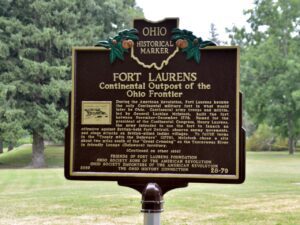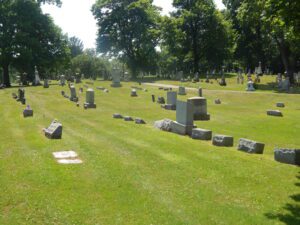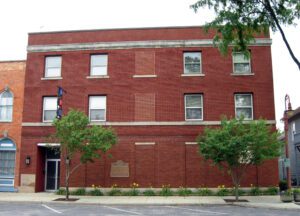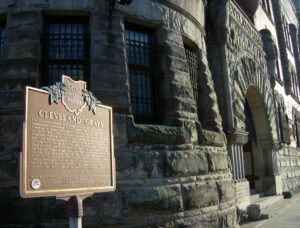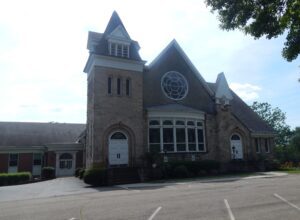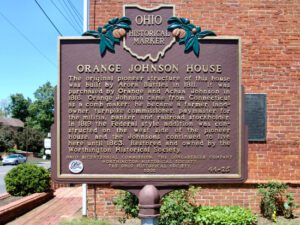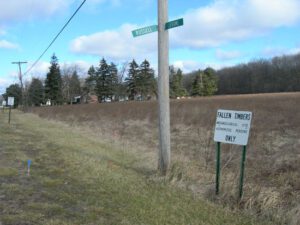, OH
During the American Revolution, Fort Laurens became the only Continental military fort in what would later be Ohio. Continental army troops and militia, led by General Lachlan McIntosh, built the fort between November-December 1778. Named for the president of the Continental Congress, Henry Laurens, the army intended to use the fort to launch an offensive against British-held Fort Detroit, observe enemy movements, and stage attacks on British-allied Indian villages. To fulfill terms in the “Treaty with the Delaware” (1778), McIntosh chose a site about two miles south of the “Great Crossing” on the Tuscarawas River in friendly Lenape (Delaware) territory. (Continued on other side)
, OH
For more than two centuries, this burial ground has been a final resting place for those individuals whose lives represented the community history of Canfield. The earliest existing tombstone marks the death of Huldah Tanner in 1803. Seven earlier deaths in Canfield Township are recorded from 1798 to 1803, but the gravesites are unknown. Elijah and Rhoda Hopkins Wadsworth formally deeded the cemetery to the citizens of Canfield in 1810 with a first edition of land donated by Matthew B. Whittlesey in 1811. In 1862-1863, the graveyard was again enlarged. For seventy years the cemetery and fencing were maintained on a volunteer basis. When the Village of Canfield was incorporated in 1869, the care and management was vested in a board of trustees. (continued on other side)
, OH
On March 5, 1817, Lieutenant Almon Gibbs, formerly of Army Lodge No. 24 at Fort Meigs, Perrysburg, formed Northern Light Lodge No. 40 “at Waynesfield” (now Maumee). Gibbs served as Worshipful Master, William Griffith as Senior Warden, and Charles Gunn, Junior Warden. The lodge was founded under a dispensation from Henry Brush, Ohio Grand Master and Captain of the Ohio Militia. Among many prominent early members was General James B. Steadman of Chickamauga fame. Almon Gibbs later became Maumee’s first postmaster and Justice of the Peace. [Masonic Symbol]
, OH
Ohio’s oldest surviving municipal market house, Findlay Market was designed under the direction of City Civil Engineer Alfred West Gilbert (1816-1900). It was listed on the National Register of Historic Places in 1972. The structure was among the first market houses in the United States to use iron frame construction technology. Originally an open pavilion, much of the market was erected in 1852, but disputes with contractors delayed its opening until 1855. The center masonry tower was built in 1902. Soon after, public health concerns prompted enclosure of the market stalls and the addition of plumbing and refrigeration. Until then, vendors found cool storage in deep cellars beneath nearby breweries. The tower bell was brought from Cincinnati’s Pearl Street Market in 1934. Findlay Market was renovated in 1973-74 and again in 2002-03.
, OH
The Cleveland Grays were organized by statute in 1837 as an independent volunteer militia company. The Grays were the first company to leave Cleveland for service during the Civil War. In April 1861, they were designated Company E, 1st Ohio Volunteer Infantry (OVI). They saw action at Vienna Station and First Manassas and also served in the 84th OVI and were on duty with the 150th OVI at Fort Stephens when Confederate General Jubal Early attacked Washington in the summer of 1864. During the Spanish-American War the Grays volunteered for service and were admitted to the National Guard as the 1st Battalion of Engineers, 10th OVI. In 1916, they joined General John J. Pershing’s Punitive Expedition against Mexico. After service on the Mexican border, the Grays became part of the 1st Battalion, 148th Infantry Regiment, 37th “Buckeye” Division. (continued on other side)
, OH
In 1798, Judge Turhand Kirtland came to Township 1, Range 1 as an agent of the Connecticut Land Company. In 1804, Kirtland donated the Village Green and the graveyard adjoining the church to the residents of Poland. On the Green, the settlers built a log meetinghouse and school. Prior to 1812, the local militia drilled here and, in 1861, young men trained here before leaving to fight in the Civil War. The graveyard contains some 450 graves of early families of Poland, including settlers such as Kirtland, Fowler, Walker, Morse, Arrel, Adair, Lee, McCombs, and Truesdale. Among those buried here are thirteen Revolutionary War veterans, thirteen veterans of the War of 1812, and ten men who fought in the Civil War. In 1862, Samuel K. Hine provided in his will for the maintenance of both the Graveyard and the Green.
, OH
The original pioneer structure of this house was built by Arora Buttles in 1811. It was purchased by Orange and Achsa Johnson in 1816. Orange Johnson came from Connecticut as a comb maker; he became a farmer, landowner, turnpike commissioner, paymaster for the militia, banker, and railroad stockholder. In 1819 the Federal style addition was constructed on the west side of the pioneer house, and the Johnsons continued to live here until 1863. Restored and owned by the Worthington Historical Society.
, OH
The Battle of Fallen Timbers, fought on August 20, 1794, is one of the most significant events relating to post-Revolutionary War America. Major General “Mad” Anthony Wayne led the Federal Army, known as The Legion of the United States against a confederacy of Native Americans led by Miami Chief Little Turtle and Shawnee war chief Blue Jacket. Defeat in battle and lack of help from their nearby British allies disheartened the tribes and lead to the 1795 Treaty of Greenville. The Treaty secured United States control of the Northwest Territory and ultimately resulted in the formation of five new states-Ohio, Indiana, Michigan, Illinois, and Wisconsin. (continued on other side)


